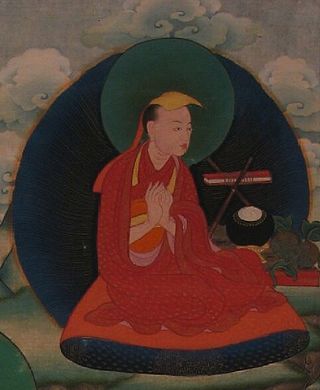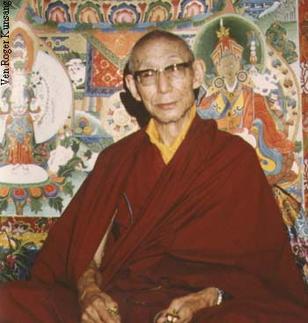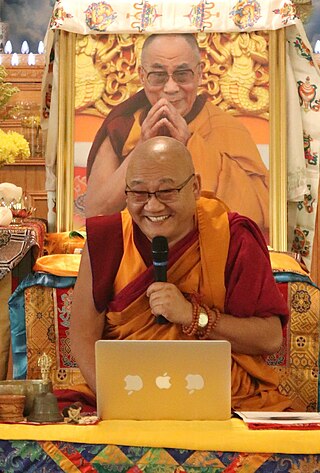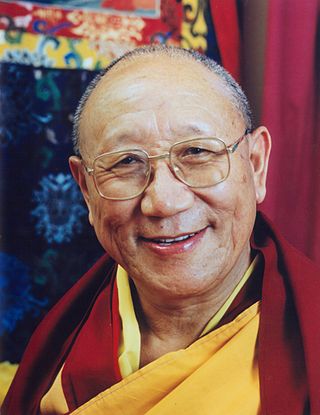
Tibetan Buddhism is a form of Buddhism practiced in Tibet, Bhutan and Mongolia. It also has a sizable number of adherents in the areas surrounding the Himalayas, including the Indian regions of Ladakh, Sikkim, and Arunachal Pradesh, as well as in Nepal. Smaller groups of practitioners can be found in Central Asia, Xinjiang, Inner Mongolia, and some regions of Russia, such as Tuva, Buryatia, and Kalmykia.
The Bodhisattvacaryāvatāra or Bodhicaryāvatāra translated into English as A Guide to the Bodhisattva's Way of Life, is a Mahāyāna Buddhist text written c. 700 AD in Sanskrit verse by Shantideva (Śāntideva), a Buddhist monk at Nālandā Monastic University in India which is also where it was composed.

The Gelug is the newest of the four major schools of Tibetan Buddhism. It was founded by Je Tsongkhapa (1357–1419), a Tibetan philosopher, tantric yogi and lama and further expanded and developed by his disciples.

The Kadam school of Tibetan Buddhism was an 11th century Buddhist tradition founded by the great Bengali master Atiśa (982-1054) and his students like Dromtön (1005–1064), a Tibetan Buddhist lay master. The Kadampa stressed compassion, pure discipline and study.

The Ganden Tripa, also spelled Gaden Tripa, is the title of the spiritual leader of the Gelug school of Tibetan Buddhism, the school that controlled central Tibet from the mid-17th century until the 1950s. The 103rd Ganden Tripa, Jetsun Lobsang Tenzin, died in office on 21 April 2017. Currently, Jangtse Choejey Kyabje Jetsun Lobsang Tenzin Palsangpo is the 104th Ganden Tripa.

Stephen Batchelor is a Scottish Buddhist author and teacher, known for his writings on Buddhist subjects and his leadership of meditation retreats worldwide. He is a noted proponent of agnostic or secular Buddhism.

Tsongkhapa was an influential Tibetan Buddhist monk, philosopher and tantric yogi, whose activities led to the formation of the Gelug school of Tibetan Buddhism. He is also known by his ordained name Losang Drakpa or simply as "Je Rinpoche". He is also known by Chinese as Zongkapa Lobsang Zhaba or just Zōngkābā (宗喀巴).
Geshe or geshema is a Tibetan Buddhist academic degree for monks and nuns. The degree is emphasized primarily by the Gelug lineage, but is also awarded in the Sakya and Bön traditions. The equivalent geshema degree is awarded to women.
Ngawang Wangyal, aka Sogpo (Mongolian) Wangyal, popularly known as Geshe Wangyal and "America's first lama," was a Buddhist lama and scholar of Kalmyk origin. He was born in the Astrakhan province in southeast Russia sometime in 1901 and died in West Palm Beach, Florida in 1983. He came to the United States from Tibet in 1955 and was the spiritual leader of the Kalmuk Buddhist community in Freewood Acres, New Jersey at the Rashi Gempil-Ling Buddhist Temple. He is considered a "founding figure" of Buddhism in the West.

Monlam, also known as The Great Prayer Festival, falls on the 4th to 11th day of the 1st Tibetan month in Tibetan Buddhism.

Kumbum Monastery, also called Ta'er Temple, is a Tibetan gompa in Lusar, Huangzhong County, Xining, Qinghai, China. It was founded in 1583 in a narrow valley close to the village of Lusar in the historical Tibetan region of Amdo. Its superior monastery is Drepung Monastery, immediately to the west of Lhasa. It is ranked in importance as second only to Lhasa.

Zong Rinpoche was a Gelug Lama and disciple of the third Trijang Rinpoche, junior tutor of the 14th Dalai Lama. He was famous as a sharp analyst and master of philosophical debate, as well as a powerful Tantric practitioner. He was the Abbot of Ganden Shartse monastery.

The 14th Dalai Lama, known to the Tibetan people as Gyalwa Rinpoche, is, as the incumbent Dalai Lama, the highest spiritual leader and head of Tibet. He is considered a living Bodhisattva; specifically, an emanation of Avalokiteśvara in Sanskrit, and Chenrezig in Tibetan. He is also the leader and a monk of the Gelug school, the newest school of Tibetan Buddhism, formally headed by the Ganden Tripa. The central government of Tibet, the Ganden Phodrang, invested the Dalai Lama with temporal duties until his exile in 1959.

The Tibet Institute Rikon is a Tibetan monastery located in Zell-Rikon im Tösstal in the Töss Valley in Switzerland. It was established as a non-profit foundation in 1968, because Swiss laws resulting from the 19th century secularization movement did not allow for the establishment of new monasteries until 1973.

Rato Dratsang, also known as Rato Monastery, Rato Dratsang is a Tibetan Buddhist monastery of the Gelug or "Yellow Hat" order. For many centuries, Rato Dratsang was an important monastic center of Buddhist studies in Central Tibet.

Kyabje Yongzin Ling Rinpoche is a Tibetan tulku. The best-known incarnation is the sixth incarnation, Thupten Lungtok Namgyal Thinley, a Tibetan buddhist scholar and teacher.

The Third Trijang Rinpoche, Lobsang Yeshe Tenzin Gyatso (1901–1981) was a Gelugpa Lama and a direct disciple of Pabongkhapa Déchen Nyingpo. He succeeded Ling Rinpoche as the junior tutor of the 14th Dalai Lama when the Dalai Lama was nineteen years old. He was also a lama of many Gelug lamas who taught in the West including Zong Rinpoche, Geshe Rabten, Lama Yeshe, Kelsang Gyatso, and Lama Zopa Rinpoche. Trijang Rinpoche's oral teachings were recorded by Zimey Rinpoche in a book called the Yellow Book.

Geshe Thupten Phelgye is a Tibetan Buddhist lama who is known for promoting vegetarianism and humane treatment of animals, and for his work as a peace activist. Geshe Thupten Phelgye represents the Gelug tradition in the Tibetan Parliament in Exile.

Nicholas Vreeland, also known as Rato Khen Rinpoche, Geshe Thupten Lhundup, is a fully ordained Tibetan Buddhist monk who is the abbot of Rato Dratsang Monastery, a 10th-century Tibetan Buddhist monastery reestablished in India. Vreeland is also a photographer. He is the son of Ambassador Frederick Vreeland and grandson of Diana Vreeland, the fashion editor.

Kyabje Khensur Kangurwa Lobsang Thubten Rinpoche, was a Buddhist monk, Abbot of Sera Jey Monastery, and the founder of Tibetan Buddhist Institute (Adelaide). Khensur means "former abbot" and Rinpoche means "precious teacher."


















